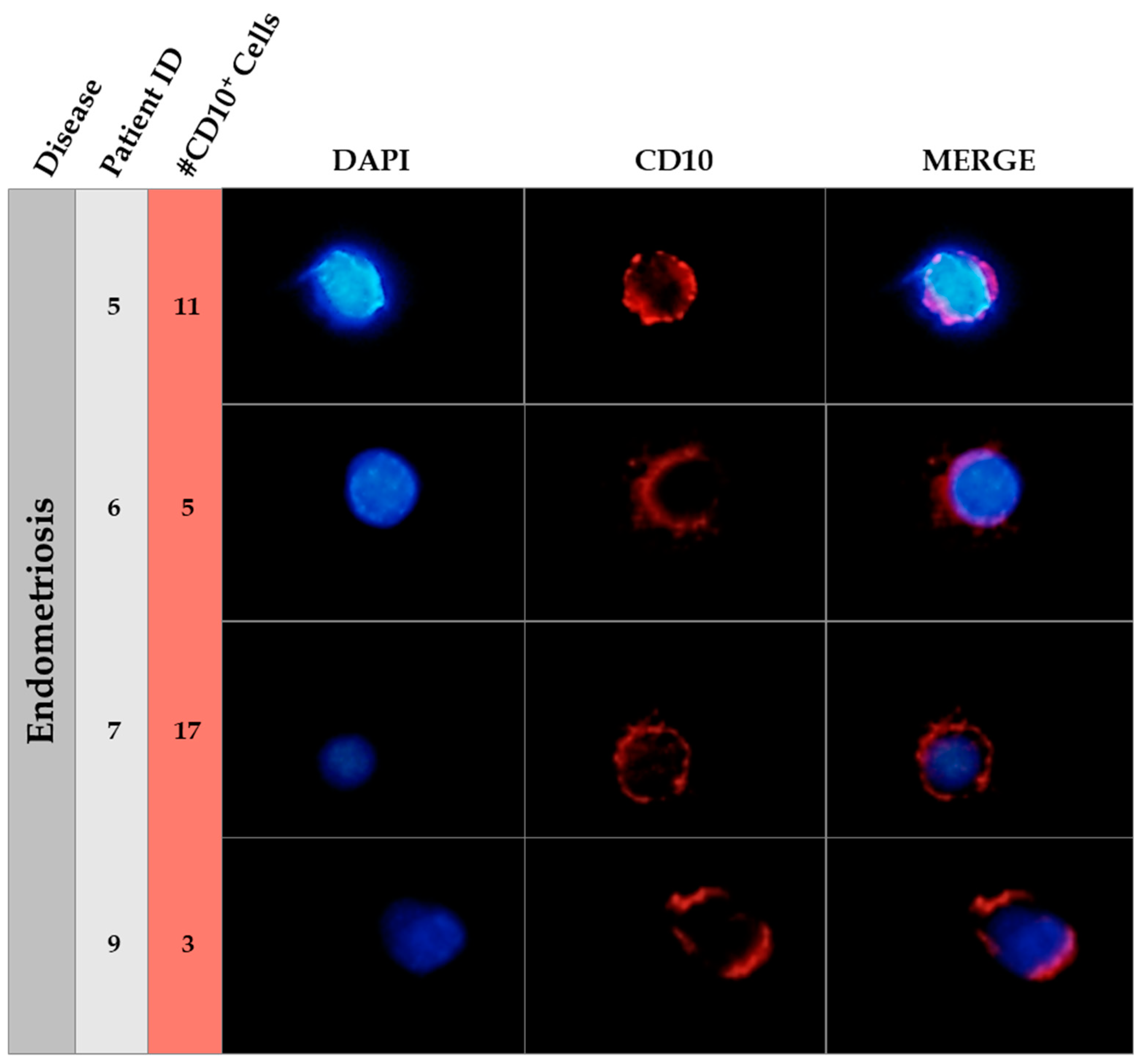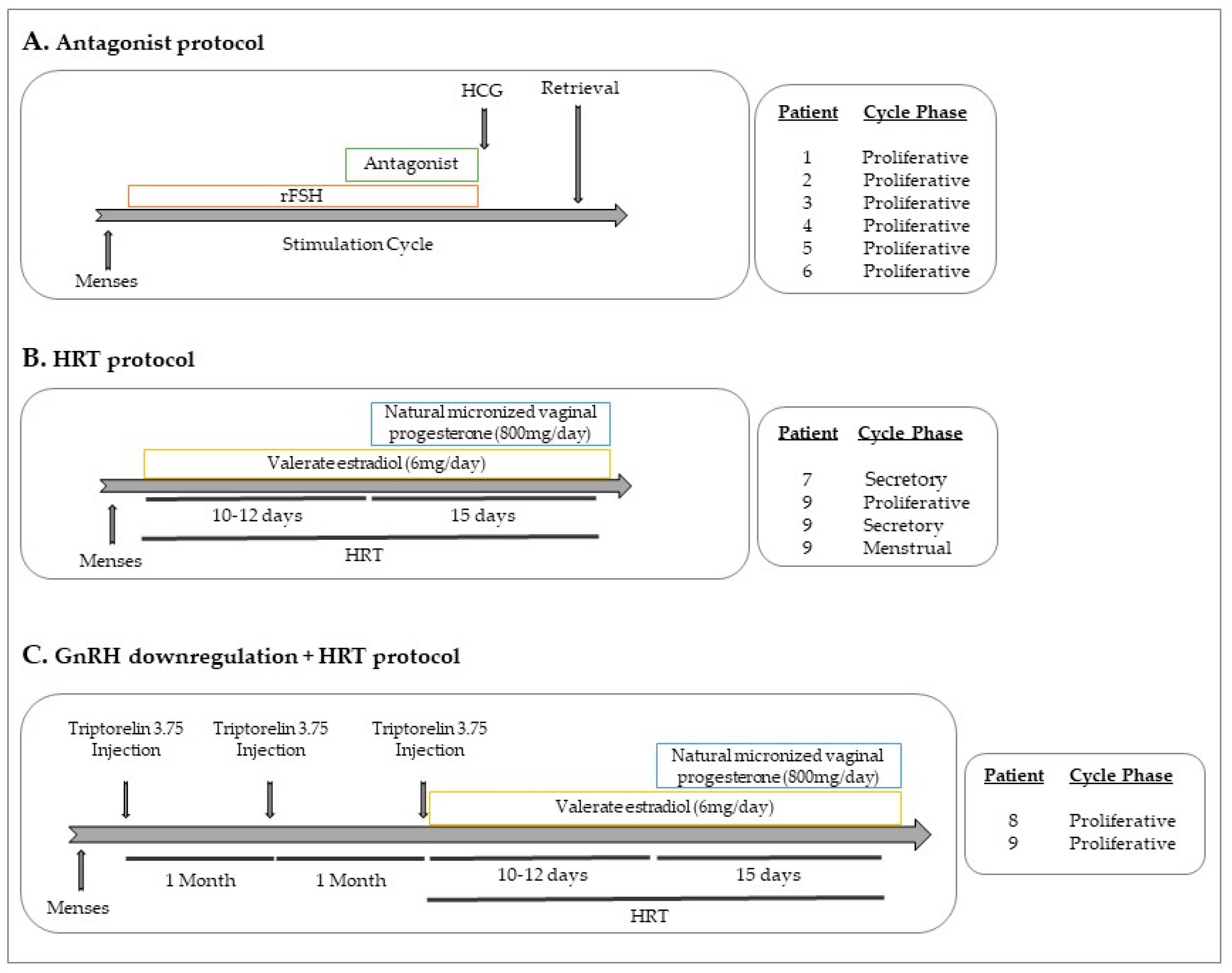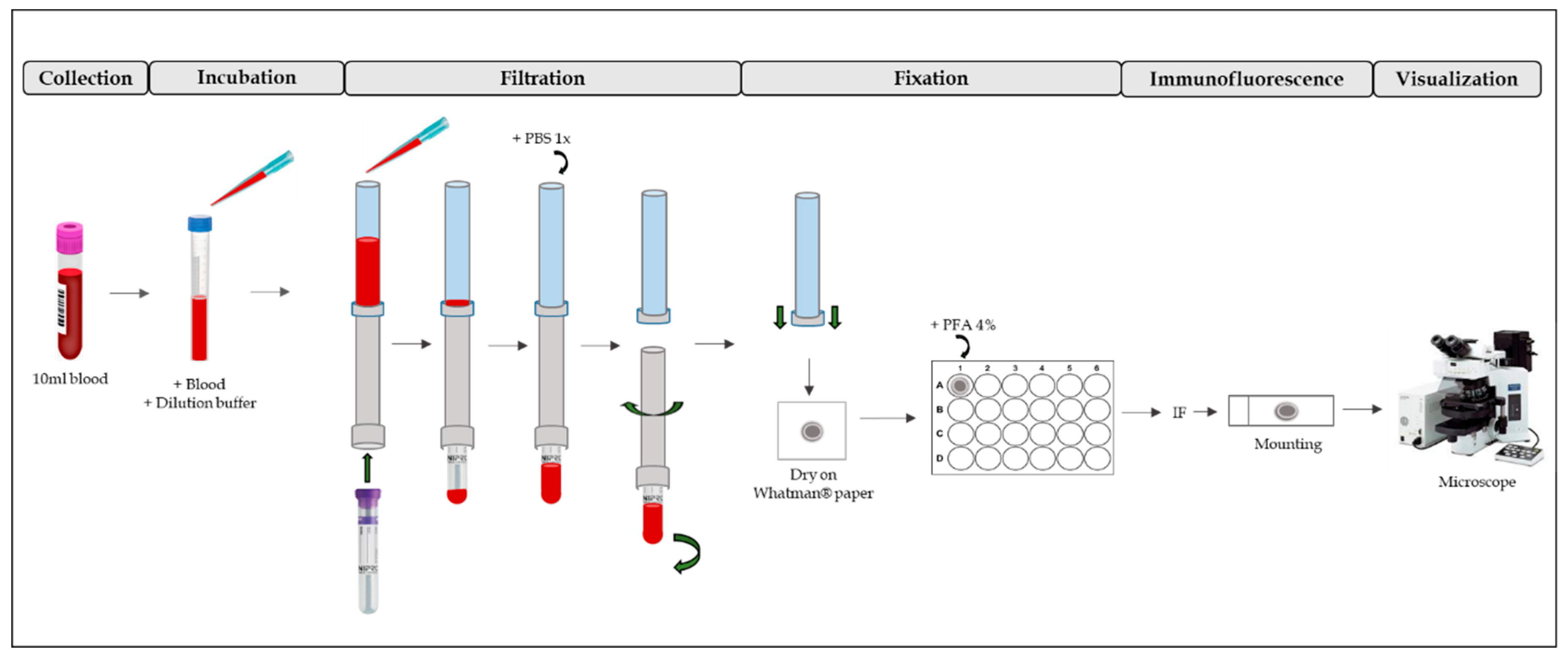Endometrial Stromal Cells Circulate in the Bloodstream of Women with Endometriosis: A Pilot Study
Abstract
1. Introduction
2. Results
Isolation and Detection of Circulating Endometrial Cells (CECs): Immunofluorescence
3. Discussion
4. Material and Methods
4.1. Subjects
4.2. Sample Collection
4.3. Sample Processing
4.4. Detection of CECs: Immunofluorescence
Author Contributions
Funding
Acknowledgments
Conflicts of Interest
Abbreviations
| CD10 | Common acute lymphoblastic leukemia-associated |
| CECs | Circulating Endometrial Cells |
| CK | Cytokeratin |
| COS | Controlled Ovarian Stimulation |
| CRCs | Circulating Rare Cells |
| CTCs | Circulating Tumor Cells |
| DIE | Deep Infiltrating Endometriosis |
| EMT | Epithelial Mesenchymal Transition |
| EpCAM | Epithelial Cell Adhesion Molecule |
| FDA | Food and Drug Administration |
| GnRH | Gonadotropin Releasing Hormone |
| IHC | Immunohistochemistry |
| IF | Immunofluorescence |
| LGR5 | Leucine-Rich Repeat Containing G Protein-Coupled Receptor 5 |
| rFSH | Recombinant follicular stimulating hormone |
References
- Giudice, L.C. Clinical Practice: Endometriosis. N. Engl. J. Med. 2010, 362, 2389–2398. [Google Scholar] [CrossRef]
- Zondervan, K.T.; Becker, C.M.; Koga, K.; Missmer, S.A.; Taylor, R.N.; Viganò, P. Endometriosis. Nat. Rev. Dis. Prim. 2018, 4, 9. [Google Scholar] [CrossRef]
- Laganà, A.S.; La Rosa, V.L.; Rapisarda, A.M.C.; Valenti, G.; Sapia, F.; Chiofalo, B.; Rossetti, D.; Ban Frangež, H.; Vrtačnik Bokal, E.; Giovanni Vitale, S. Anxiety and depression in patients with endometriosis: Impact and management challenges. Int. J. Womens Health 2017, 9, 323–330. [Google Scholar] [CrossRef]
- Burney, R.O.; Giudice, L.C. Pathogenesis and pathophysiology of endometriosis. Fertil. Steril. 2012, 98, 511–519. [Google Scholar] [CrossRef]
- Sourial, S.; Tempest, N.; Hapangama, D.K. Theories on pathogenesis of endometriosis. Int. J. Reprod. Med. 2014, 2014, 179515. [Google Scholar] [CrossRef]
- Sampson, J.A. Metastatic or embolic endometriosis, due to the menstrual dissemination of endometrial tissue into the venous circulation. Am. J. Pathol. 1927, 3, 81–82. [Google Scholar]
- Laganà, A.S.; Vitale, S.G.; Salmeri, F.M.; Triolo, O.; Ban Frangež, H.; Vrtačnik-Bokal, E.; Stojanovska, L.; Apostolopoulos, V.; Granese, R.; Sofo, V. Unus pro omnibus, omnes pro uno: A novel, evidence-based, unifying theory for the pathogenesis of endometriosis. Med. Hypotheses 2017, 103, 10–20. [Google Scholar] [CrossRef]
- Du, H.; Taylor, H.S. Contribution of Bone Marrow-Derived Stem Cells to Endometrium and Endometriosis. Stem Cells 2007, 25, 2082–2086. [Google Scholar] [CrossRef]
- Götte, M.; Wolf, M.; Staebler, A.; Buchweitz, O.; Kelsch, R.; Schüring, A.N.; Kiesel, L. Increased expression of the adult stem cell marker Musashi-1 in endometriosis and endometrial carcinoma. J. Pathol. 2008, 215, 317–329. [Google Scholar] [CrossRef]
- Pluchino, N.; Taylor, H.S. Endometriosis and Stem Cell Trafficking. Reprod. Sci. 2016, 23, 1616–1619. [Google Scholar] [CrossRef]
- Sasson, I.E.; Taylor, H.S. Stem cells and the pathogenesis of endometriosis. Ann. N. Y. Acad. Sci. 2008, 1127, 106–115. [Google Scholar] [CrossRef]
- Santamaria, X.; Massasa, E.E.; Taylor, H.S. Migration of cells from experimental endometriosis to the uterine endometrium. Endocrinology 2012, 153, 5566–5574. [Google Scholar] [CrossRef]
- Li, F.; Alderman, M.H.; Tal, A.; Mamillapalli, R.; Coolidge, A.; Hufnagel, D.; Wang, Z.; Neisani, E.; Gidicsin, S.; Krikun, G.; et al. Hematogenous Dissemination of Mesenchymal Stem Cells from Endometriosis. Stem Cells 2018, 36, 881–890. [Google Scholar] [CrossRef]
- Vallvé-Juanico, J.; Suárez-Salvador, E.; Castellví, J.; Ballesteros, A.; Taylor, H.S.; Gil-Moreno, A.; Santamaria, X. Aberrant expression of epithelial leucine-rich repeat containing G protein–coupled receptor 5–positive cells in the eutopic endometrium in endometriosis and implications in deep-infiltrating endometriosis. Fertil. Steril. 2017, 108, 858–867. [Google Scholar] [CrossRef]
- Cervelló, I.; Gil-Sanchis, C.; Santamaría, X.; Faus, A.; Vallvé-Juanico, J.; Díaz-Gimeno, P.; Genolet, O.; Pellicer, A.; Simón, C. Leucine-rich repeat–containing G-protein–coupled receptor 5–positive cells in the endometrial stem cell niche. Fertil. Steril. 2017, 107, 510–519. [Google Scholar] [CrossRef]
- Madala, S.K.; Pesce, J.T.; Ramalingam, T.R.; Wilson, M.S.; Minnicozzi, S.; Cheever, A.W.; Thompson, R.W.; Mentink-Kane, M.M.; Wynn, T.A. Matrix Metalloproteinase 12-Deficiency Augments Extracellular Matrix Degrading Metalloproteinases and Attenuates IL-13– Dependent Fibrosis. J. Immunol. 2010, 184, 3955–3963. [Google Scholar] [CrossRef]
- Fassbender, A.; Dorien, O.; De Moor, B.; Waelkens, E.; Meuleman, C.; Tomassetti, C.; Peeraer, K.; D’Hooghe, T. Biomarkers of endometriosis. Fertil. Steril. 2013, 99, 1135–1145. [Google Scholar] [CrossRef]
- Desitter, I.; Guerrouahen, B.S.; ali-Furet, N.; Wechsler, J.; Janne, P.A.; Kuang, Y.; Yanagita, M.; Wang, L.; Berkowitz, J.A.; Distel, R.J.; et al. A new device for rapid isolation by size and characterization of rare circulating tumor cells. Anticancer Res. 2011, 31, 427–441. [Google Scholar]
- El-Heliebi, A.; Kroneis, T.; Zöhrer, E.; Haybaeck, J.; Fischereder, K.; Kampel-Kettner, K.; Zigeuner, R.; Pock, H.; Riedl, R.; Stauber, R.; et al. Are morphological criteria sufficient for the identification of circulating tumor cells in renal cancer? J. Transl. Med. 2013, 11, 1–17. [Google Scholar] [CrossRef]
- Kulemann, B.; Pitman, M.B.; Liss, A.S.; Valsangkar, N.; Fernández-Del Castillo, C.; Lillemoe, K.D.; Hoeppner, J.; Mino-Kenudson, M.; Warshaw, A.L.; Thayer, S.P. Circulating tumor cells found in patients with localized and advanced pancreatic cancer. Pancreas 2015, 44, 547–550. [Google Scholar] [CrossRef]
- Chen, C.; Mahalingam, D.; Osmulski, P.; Jadhav, R.R.; Wang, M.; Leach, R.J.; Chang, T.; Weitman, S.D.; Pratap, A.; Sun, L.; et al. HHS Public Access Single-cell analysis of circulating tumor cells identifies cumulative expression patterns of EMT-related genes in metastatic prostate cancer. Prostate 2016, 73, 813–826. [Google Scholar] [CrossRef]
- Mascalchi, M.; Falchini, M.; Maddau, C.; Salvianti, F.; Nistri, M.; Bertelli, E.; Sali, L.; Zuccherelli, S.; Vella, A.; Matucci, M.; et al. Prevalence and number of circulating tumour cells and microemboli at diagnosis of advanced NSCLC. J. Cancer Res. Clin. Oncol. 2016, 142, 195–200. [Google Scholar] [CrossRef]
- Allard, W.J.; Matera, J.; Miller, M.C.; Repollet, M.; Connelly, M.C.; Rao, C.; Tibbe, A.G.J.; Uhr, J.W.; Terstappen, L.W.M.M. Tumor Cells Circulate in the Peripheral Blood of All Major Carcinomas but not in Healthy Subjects or Patients With Nonmalignant Diseases Tumor Cells Circulate in the Peripheral Blood of All Major Carcinomas but not in Healthy Subjects or Patients With Non. Clin. Cancer Res. 2005, 10, 6897–6904. [Google Scholar] [CrossRef]
- Riethdorf, S.; Wikman, H.; Pantel, K. Review: Biological relevance of disseminated tumor cells in cancer patients. Int. J. Cancer 2008, 123, 1991–2006. [Google Scholar] [CrossRef]
- Hong, B.; Zu, Y. Detecting circulating tumor cells: Current challenges and new trends. Theranostics 2013, 3, 377–394. [Google Scholar] [CrossRef]
- Cristofanilli, M.; Budd, G.T.; Ellis, M.J.; Stopeck, A.; Matera, J.; Miller, M.C.; Reuben, J.M.; Doyle, J.V.; Allard, W.J.; Terstappen, L.W.M.M.; et al. Circulating Tumor Cells, Disease Progression, and Survival in Metastatic Breast. Cancer Engl. J. 2004, 351, 781–791. [Google Scholar]
- Bidard, F.-C.; Peeters, D.J.; Fehm, T.; Nolé, F.; Gisbert-Criado, R.; Mavroudis, D.; Grisanti, S.; Generali, D.; Garcia-Saenz, J.A.; Stebbing, J.; et al. Clinical validity of circulating tumour cells in patients with metastatic breast cancer: A pooled analysis of individual patient data. Lancet Oncol. 2014, 15, 406–414. [Google Scholar] [CrossRef]
- Budd, G.T.; Cristofanilli, M.; Ellis, M.J.; Stopeck, A.; Borden, E.; Miller, M.C.; Matera, J.; Repollet, M.; Doyle, G.V.; Terstappen, L.W.M.M.; et al. Circulating tumor cells versus imaging—Predicting overall survival in metastatic breast cancer. Clin. Cancer Res. 2006, 12, 6403–6409. [Google Scholar] [CrossRef]
- Hayes, D.F.; Cristofanilli, M.; Budd, G.T.; Ellis, M.J.; Stopeck, A.; Miller, M.C.; Matera, J.; Allard, W.J.; Doyle, G.V.; Terstappen, L.W.W.M. Circulating tumor cells at each follow-up time point during therapy of metastatic breast cancer patients predict progression-free and overall survival. Clin. Cancer Res. 2006, 12, 4218–4224. [Google Scholar] [CrossRef]
- Aktas, B.; Tewes, M.; Fehm, T.; Hauch, S.; Kimmig, R.; Kasimir-Bauer, S. Stem cell and epithelial-mesenchymal transition markers are frequently overexpressed in circulating tumor cells of metastatic breast cancer patients. Breast Cancer Res. 2009, 11, 1–9. [Google Scholar] [CrossRef]
- Papadaki, M.A. Co-expression of putative stemness and epithelial-to- mesenchymal transition markers on single circulating tumour cells from patients with early and metastatic breast cancer. BMC Cancer 2014, 1–10. [Google Scholar] [CrossRef]
- Momburg, F.; Moldenhauer, G.; Hämmerling, G.J.; Möller, P. Immunohistochemical study of the expression of a Mr 34,000 human epithelium-specific surface glycoprotein in normal and malignant tissues. Cancer Res. 1987, 47, 2883–2891. [Google Scholar]
- McCluggage, W.G.; Sumathi, V.P.; Maxwell, P. CD10 is a sensitive and diagnostically useful immunohistochemical marker of normal endometrial stroma and of endometrial stromal neoplasms. Histopathology 2001, 39, 273–278. [Google Scholar] [CrossRef]
- Onda, T.; Ban, S.; Shimizu, M. CD10 is useful in demonstrating endometrial stroma at ectopic sites and in confirming a diagnosis of endometriosis. J. Clin. Pathol. 2003, 56, 79. [Google Scholar] [CrossRef][Green Version]
- Brady, K.A.; Atwater, S.K.; Lowell, C. A Flow cytometric detection of CD10 (cALLA) on peripheral blood B lymphocytes of neonates. Br. J. Haematol. 1999, 107, 712–715. [Google Scholar] [CrossRef]
- Yuan, C.M.; Vergilio, J.A.; Zhao, X.F.; Smith, T.K.; Harris, N.L.; Bagg, A. CD10 and BCL6 expression in the diagnosis of angioimmunoblastic T-cell lymphoma: Utility of detecting CD10+ T cells by flow cytometry. Hum. Pathol. 2005, 36, 784–791. [Google Scholar] [CrossRef]
- Chen, L.; Bode, A.M.; Dong, Z. Circulating Tumor Cells: Moving Biological Insights into Detection. Theranostics 2017, 7, 2606–2619. [Google Scholar] [CrossRef]
- Miller, J.E.; Ahn, S.H.; Monsanto, S.P.; Khalaj, K.; Koti, M.; Tayade, C. Implications of immune dysfunction on endometriosis associated infertility. Oncotarget 2015, 8, 7138–7147. [Google Scholar] [CrossRef]
- Bobek, V.; Kolostova, K.; Kucera, E. Circulating endometrial cells in peripheral blood. Eur. J. Obstet. Gynecol. Reprod. Biol. 2014, 181, 267–274. [Google Scholar] [CrossRef]
- Chen, Y.; Zhu, H.L.; Tang, Z.W.; Neoh, K.H.; Ouyang, D.F.; Cui, H.; Cheng, H.Y.; Ma, R.Q.; Ye, X.; Han, R.P.S.; et al. Evaluation of circulating endometrial cells as a biomarker for endometriosis. Chin. Med. J. (Engl.) 2017, 130, 2339–2345. [Google Scholar]
- Ni, T.; Sun, X.; Shan, B.; Wang, J.; Liu, Y.; Gu, S.L.; Wang, Y.D. Detection of circulating tumour cells may add value in endometrial cancer management. Eur. J. Obstet. Gynecol. Reprod. Biol. 2016, 207, 1–4. [Google Scholar] [CrossRef]
- Zuo, L.; Niu, W.; Li, A. Isolation of Circulating Tumor Cells of Ovarian Cancer by Transferrin Immunolipid Magnetic Spheres and Its Preliminary Clinical Application. Nano Life 2019, 9, 1940001. [Google Scholar] [CrossRef]
- Zhang, Y.; Qu, X.; Qu, P.P. Value of circulating tumor cells positive for thyroid transcription factor-1 (TTF-1) to predict recurrence and survival rates for endometrial carcinoma. J. BUON 2016, 21, 1491–1495. [Google Scholar]
- Obermayr, E.; Sanchez-Cabo, F.; Tea, M.K.M.; Singer, C.F.; Krainer, M.; Fischer, M.B.; Sehouli, J.; Reinthaller, A.; Horvat, R.; Heinze, G.; et al. Assessment of a six gene panel for the molecular detection of circulating tumor cells in the blood of female cancer patients. BMC Cancer 2010, 10, 666. [Google Scholar] [CrossRef]
- Koelbl, A.C.; Wellens, R.; Koch, J.; Rack, B.; Hutter, S.; Friese, K.; Jeschke, U.; Andergassen, U. Endometrial Adenocarcinoma: Analysis of Circulating Tumour Cells by RT-qPCR. Anticancer Res. 2016, 36, 3205–3209. [Google Scholar]
- Lemech, C.R.; Ensell, L.; Paterson, J.C.; Eminowicz, G.; Lowe, H.; Arora, R.; Arkenau, H.T.; Widschwendter, M.; MacDonald, N.; Olaitan, A.; et al. Enumeration and Molecular Characterisation of Circulating Tumour Cells in Endometrial Cancer. Oncology 2016, 91, 48–54. [Google Scholar] [CrossRef]
- Zhang, X.; Li, H.; Yu, X.; Li, S.; Lei, Z.; Li, C.; Zhang, Q.; Han, Q.; Li, Y.; Zhang, K.; et al. Analysis of Circulating Tumor Cells in Ovarian Cancer and Their Clinical Value as a Biomarker. Cell. Physiol. Biochem. 2018, 48, 1983–1994. [Google Scholar] [CrossRef]
- Rao, Q.; Zhang, Q.; Zheng, C.; Dai, W.; Zhang, B.; Ionescu-Zanetti, C.; Lin, Z.; Zhang, L. Detection of circulating tumour cells in patients with epithelial ovarian cancer by a microfluidic system. Int. J. Clin. Exp. Pathol. 2017, 10, 9599–9606. [Google Scholar]
- Muinelo-Romay, L.; Casas-Arozamena, C.; Abal, M. Liquid Biopsy in Endometrial Cancer: New Opportunities for Personalized Oncology. Int. J. Mol. Sci. 2018, 19, 2311. [Google Scholar] [CrossRef]
- Lou, E.; Vogel, R.I.; Teoh, D.; Hoostal, S.; Grad, A.; Gerber, M.; Monu, M.; Lukaszewski, T.; Deshpande, J.; Linden, M.A.; et al. Assessment of Circulating Tumor Cells as a Predictive Biomarker of Histology in Women with Suspected Ovarian Cancer. Lab Med. 2018, 49, 134–139. [Google Scholar] [CrossRef]
- Guo, Y.; Neoh, K.H.; Chang, X.; Sun, Y.; Cheng, H.; Ye, X.; Ma, R.; Han, R.P.S.; Cui, H. Diagnostic value of HE4+ circulating tumor cells in patients with suspicious ovarian cancer. Oncotarget 2018, 9, 7522–7533. [Google Scholar] [CrossRef]
- Romero-Laorden, N.; Olmos, D.; Fehm, T.; Garcia-Donas, J.; Diaz-Padilla, I. Circulating and disseminated tumor cells in ovarian cancer: A systematic review. Gynecol. Oncol. 2014, 133, 632–639. [Google Scholar] [CrossRef]
- Kolostova, K.; Spicka, J.; Matkowski, R.; Bobek, V. Isolation, primary culture, morphological and molecular characterization of circulating tumor cells in gynecological cancers. Am. J. Transl. Res. 2015, 7, 1203–1213. [Google Scholar]
- Ferreira, M.M.; Ramani, V.C.; Jeffrey, S.S. ScienceDirect Circulating tumor cell technologies 5. Mol. Oncol. 2016, 10, 374–394. [Google Scholar] [CrossRef]



| Patient Code | Age | Menstrual Cycle Phase | Type of Endometriosis | Stimulation | CECs | |
|---|---|---|---|---|---|---|
| CK | CD10 | |||||
| 1 | 26 | Proliferative | Control | rFSH (antagonist) | 0 | 0 |
| 2 | 31 | Proliferative | Control | rFSH (antagonist) | 0 | 0 |
| 3 | 21 | Proliferative | Control | rFSH (antagonist) | 0 | 0 |
| 4 | 22 | Proliferative | Control | rFSH (antagonist) | 0 | 0 |
| 5 | 37 | Proliferative | Endometrioma | rFSH (antagonist) | 0 | 11 |
| 6 | 36 | Proliferative | DIE | rFSH (antagonist) | 0 | 5 |
| 7 | 42 | Secretory | Endometrioma | HRT | 0 | 17 |
| 8 | 32 | Proliferative | DIE | GnRH downregulation + HRT | 0 | 0 |
| 9 | 30 | Menstrual | DIE | HRT | 0 | 3 |
| 9 | 30 | Proliferative | DIE | HRT | 0 | 57 |
| 9 | 30 | Secretory | DIE | HRT | 0 | 22 |
| 9 | 30 | Proliferative | DIE | GnRH downregulation + HRT | 0 | 3 |
| Gynecological Pathology | Benign/Malignant | CTCs/CECs Detection Technology | References |
|---|---|---|---|
| Endometrial cancer | Malignant | EpCAM based; CellSearch® and IF | [41] |
| EpCAM based; CellSearch® and IF | [46] | ||
| Density-based, Enrichment (Oncoquick) and RTqPCR | [44] | ||
| RTqPCR and flow cytometry | [43] | ||
| Size-Based Enrichment (Metacell®) and Immunodetection | [53] | ||
| RTqPCR | [45] | ||
| Review | [49] | ||
| Breast cancer | Malignant | EpCAM based; CellSearch® | [27] |
| EpCAM based; CellSearch® | [29] | ||
| EpCAM based; CellSearch® | [28] | ||
| Ovarian cancer | Malignant | EpCAM based; magnetic beads | [50] |
| ICC | [51] | ||
| Immuomagnetic bead screening and RTqPCR | [47] | ||
| Review | [52] | ||
| Immunomagnetic microspheres | [42] | ||
| Microfluidic system | [48] | ||
| Endometriosis | Benign | In culture enrichment; MetaCell® | [39] |
| IF staining via microfluidic chips | [40] | ||
| ScreenCell® | This study |
© 2019 by the authors. Licensee MDPI, Basel, Switzerland. This article is an open access article distributed under the terms and conditions of the Creative Commons Attribution (CC BY) license (http://creativecommons.org/licenses/by/4.0/).
Share and Cite
Vallvé-Juanico, J.; López-Gil, C.; Ballesteros, A.; Santamaria, X. Endometrial Stromal Cells Circulate in the Bloodstream of Women with Endometriosis: A Pilot Study. Int. J. Mol. Sci. 2019, 20, 3740. https://doi.org/10.3390/ijms20153740
Vallvé-Juanico J, López-Gil C, Ballesteros A, Santamaria X. Endometrial Stromal Cells Circulate in the Bloodstream of Women with Endometriosis: A Pilot Study. International Journal of Molecular Sciences. 2019; 20(15):3740. https://doi.org/10.3390/ijms20153740
Chicago/Turabian StyleVallvé-Juanico, Júlia, Carlos López-Gil, Agustín Ballesteros, and Xavier Santamaria. 2019. "Endometrial Stromal Cells Circulate in the Bloodstream of Women with Endometriosis: A Pilot Study" International Journal of Molecular Sciences 20, no. 15: 3740. https://doi.org/10.3390/ijms20153740
APA StyleVallvé-Juanico, J., López-Gil, C., Ballesteros, A., & Santamaria, X. (2019). Endometrial Stromal Cells Circulate in the Bloodstream of Women with Endometriosis: A Pilot Study. International Journal of Molecular Sciences, 20(15), 3740. https://doi.org/10.3390/ijms20153740




